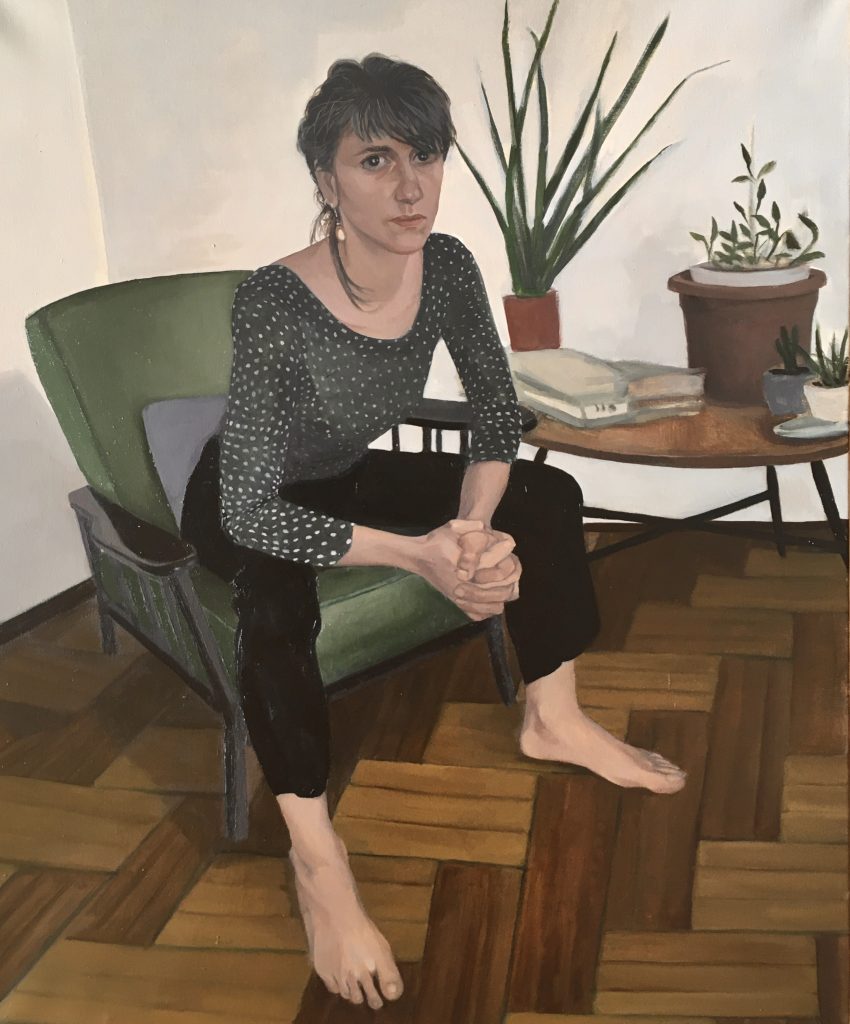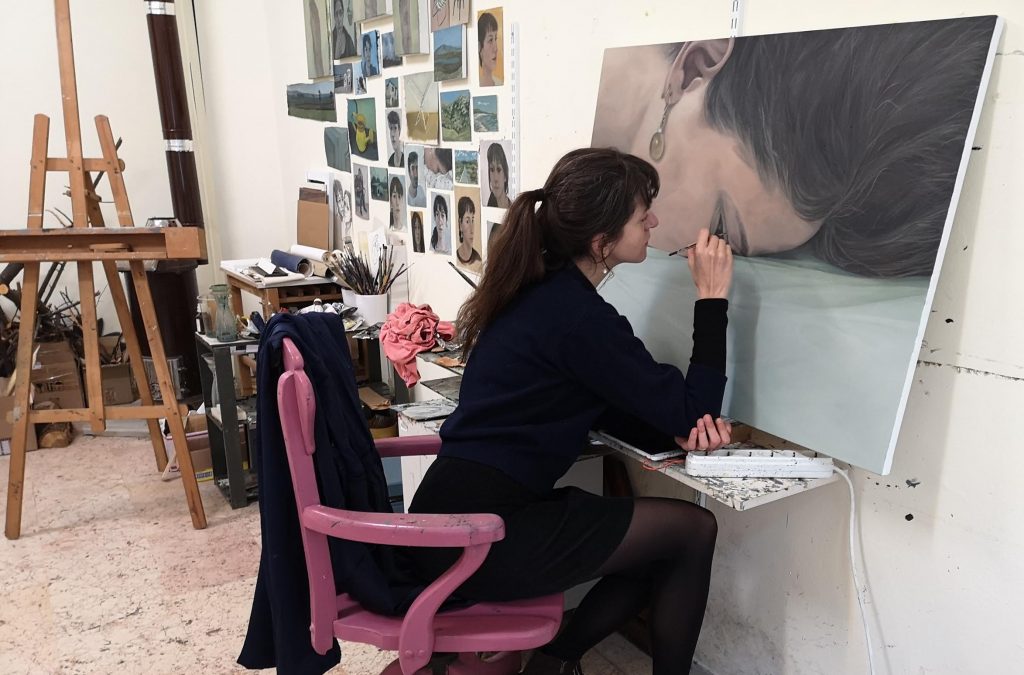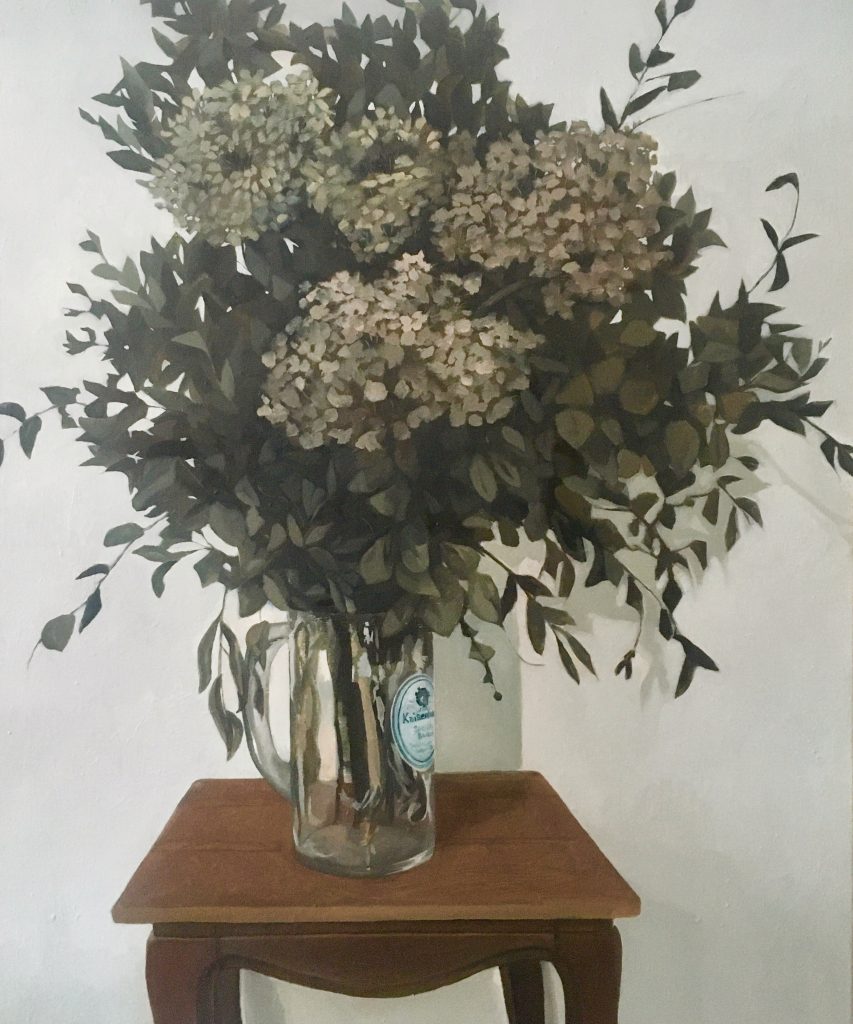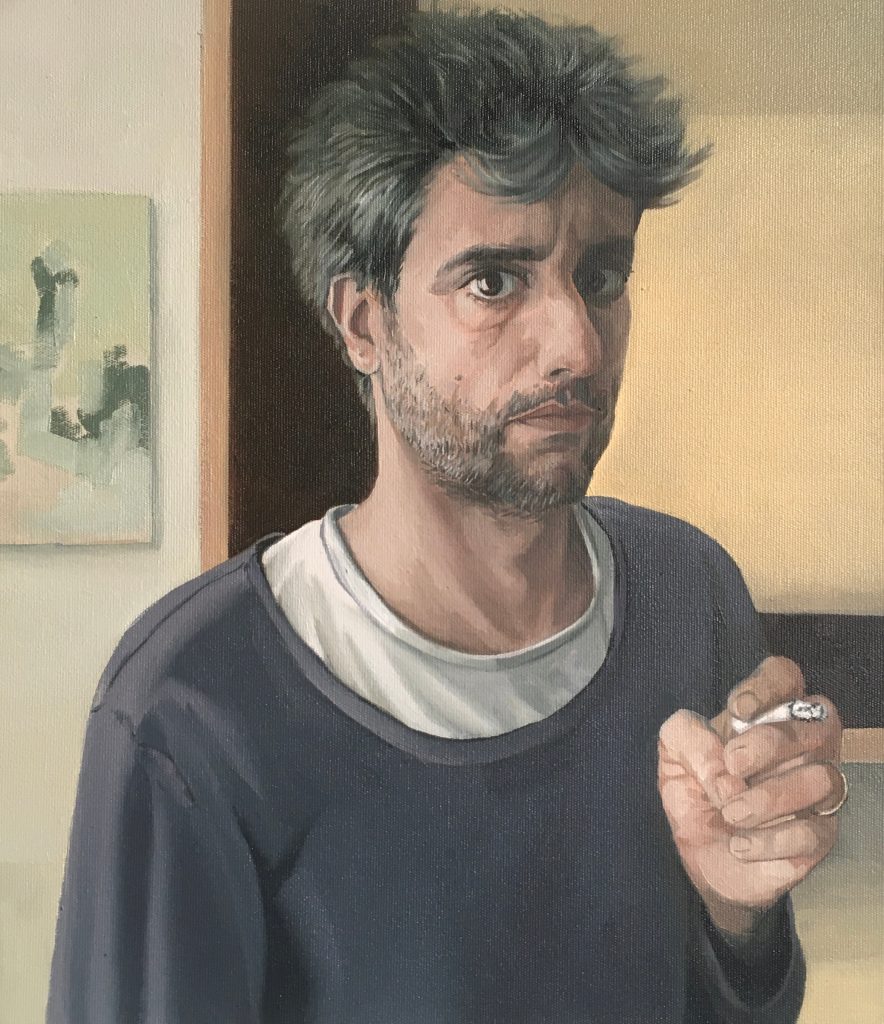by Selin Tamtekin
Interviewing Ahu Akgün, my first question is how she came up with the title for her solo show, which has just opened at Mixer in Istanbul. In sync with our times and through sheer necessity we are conducting the interview on Zoom: I’m in rural England with a window view overlooking green meadows and rolling hills, and she’s at her studio, on a quiet, uphill road in the charmingly edgy district of Yeldeğirmeni, located above one of the busiest ports on the Asian side of Istanbul.

Ahu Akgün, Erhan, oil on canvas, 50 x 40 cm, 2020, courtesy of the artist and Mixer
Through the narrow viewpoint of the shaky screen of her smartphone, she gives me a brief tour of her snug studio, along the way stopping to reveal momentary close ups of the works destined for the show, before she stands in front of the very painting it borrows its title from. The relatively small-scale oil-on-canvas is a self-portrait of the artist, seated on an armchair at home, with her legs apart, her body leaning forward, and her gaze unshyly transfixed upon the viewer.

Ahu Akgün, “My Reason to Visit” oil on canvas, 55 x 65 cm, 2020, courtesy of Mixer
A Domestic Situation Which Women in Turkey Are Used To
Akgün explains, “You know, when a man goes to ask a woman’s hand in marriage, he customarily begins by confidently saying, “The reason for our visit is...”
She’s referring to the kind of old-fashioned marriage proposal where the groom-to-be – possibly with another member from his family – pays a visit to the home of the bride-to-be, to cordially ask her parents’ permission, which is a ritual still practiced in more conservative circles in Turkey.
“This manner of speaking is never heard coming out of a woman’s mouth, and that’s why I wished to use it as my opening line. Also, because I always sit like that, with my legs apart, and I have often argued with my mother about it. She always warns me to gather my legs. It’s a domestic situation which women in Turkey are used to. That’s why, in a way, I wished to freeze such a pose and to document it, as if to say, “This is how I sit.”
The Looming Reality of the Pandemic
She had been planning to explore the notion of “distance,” as this continues to be a recurring theme in her paintings.
Getting closer to someone, being able to enter their lives, connecting with their emotions while painting them is something she has always associated with “distance.” But, since Akgün suffers from an eye condition which has reduced her vision to thirty percent, for her, distance also refers to the fear of not being able to see properly, of being unable to capture the fine details of things. Yet it seems, rather than being a true hindrance her handicap has encouraged her to develop her idiosyncratically perceptive and elaborate style.
Smiling, Akgün raises the upright palm of her hand very close to her face and says,” I work at this distance. I guess that’s why I always use small paint brushes.”

Artist Painting in her Studio
Having been offered the main gallery when she had been propositioned for a solo exhibition back in February, Akgün instead opted for their project room which is a mere 27-square meters in area. Her objective had been to treat this space, the exhibition itself as an experiment that would have her abandon her comfort zone – her studio – and instead create the artworks in situ during the sizzling-hot summer months of 2020. But when the Covid -19 pandemic broke out in Turkey in mid-March, her plans fell apart, like everybody else’s.
“I couldn’t go to my studio, I remained at home, I was paralysed with fear. All I could do in order to be able to breathe again was to paint.”
And so instead she began to prepare for the show by painting from her flat. Having had some preliminary thoughts on how she intended to approach the subject of “distance,” the looming and omnipresent reality of Covid-19 inevitably caused her to go back to the drawing board.
What’s Inside My Studio
“I decided to start by looking and observing. Therefore, I turned my head over to what’s around me, what’s inside my studio at home. What do I see? What do I feel? Then the connections between the works began to naturally form.”
The works for the exhibition comprise several paintings along with a site-specific installation. They are accompanied by a page-long text penned down by Akgün herself. As the artist has a developed a habit of taking notes for each work, in terms of what they signify for her and what ideas they have derived from, incorporating this part of her artistic practice into the show was something she wished to experiment with for the first time.
“It’s not a press release or a text that should be mounted on the wall at the entrance. What I might do is have it printed on small sheets of paper and have them put into envelopes, like a letter that visitors can then take away with them. It’s something that has a very intimate quality – I consider it to be a part of the artwork.”
I Want Them to Live
Evocative titles are weaved into the text, where a narrative of stream of consciousness sequentially underlines the inspiration of ideas and feelings behind each artwork.

Ahu Akgün, I Want Them to Live, oil on canvas, 60 x 73 cm, 2020, courtesy of the artist and Mixer
“I Want Them to Live,” a still-life of dry plants gushing out of a beer jug, in subdued colours, raises, in existential terms, the question of what constitutes being alive, or for that matter dead, as the painter reminiscences over, “those who could not experience this period because they are no longer alive.” She carries on: “I question how they would have reacted had they been alive. I crave for their beings. I want to be a mediator so that they can continue witnessing. ‘I Want Them to Live’ like dry plants.”
The exhibition, A Reason to Visit, is a moving account of an artist’s most personal reflections during the height of the Covid-19 pandemic in Turkey this Spring, during which periodic lockdowns came to force over the weekends and on public holidays, and round-the-clock confinement was implemented on an age restricted group of under 18’s and over 65’s , before lockdown measures were removed altogether at the beginning of the summer, in time for the tourist season, in the government’s bid not to bring down, in what some argue was, an already vulnerable economy close to a tipping point.
Throughout this phase, she had to co-habit the home-studio of her painter husband Levent Aygül. One of the paintings intended for the exhibition is a portrait of him titled, “We Share the Same Studio.” Referring to this painting, the artist writes: “The gazes we share prove each other’s existence.”

Ahu Akgün, We Share the Same Studio, oil on canvas, 35 x 40cm, 2020, courtesy of the artist and Mixer
Akgün agrees when I point out that perhaps one of the most difficult experiences of the pandemic for many was to be forced into solitary confinement for days on end.
Rather than just some needy urge to be around others, what some suffered from most was a kind of existential distress, since if we get down to the basics of human-to-human social interaction, we all require some else’s presence in order to prove our own.
A Mood of Melancholia
On her painting of “Erhan,” a close friend of the painter’s, which she has portrayed solemnly with his back turned, Akgün writes: “I am no longer interested in what my friends do that day, either.My only concern is, do they have a headache? A sore throat, or maybe a fever? […] How do they feel? Actually, I know what you are up to,‘Erhan.’ Because we are all at the same point. Telephone in our hands, empty walls in front of us, we lie down, then get up.”
Given that a mood of melancholia often prevails in her paintings, I ask the artist as we are nearing to the end of our interview, if the experience of the Covid-19 pandemic has further heightened this sentiment in her works.
Akgün responds, “Yes it has but also, the pandemic has inspired me to be more outspoken as an artist. It has made me think that since I have decided to devote my life to this vocation that I should give myself completely. And with this exhibition I wanted to test myself in these terms – to see how far I can go.”
This article was first published in its Turkish translation at T24. A Reason to Visit continues at Mixer, Istanbul until 31 October 2020.

